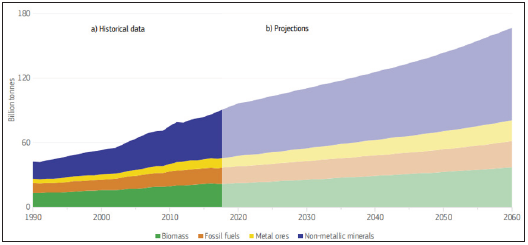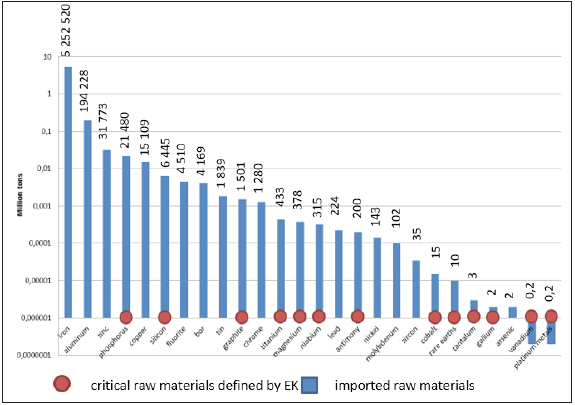- Submissions

Full Text
Aspects in Mining & Mineral Science
Are the Critical Raw Materials Equally Critical for Individual EU Member States?
Michal Cehlár* and Zuzana Šimková
Technical University of Košice, Faculty of Mining, Ecology, Process Control and Geotechnologies, Slovakia
*Corresponding author: Michal Cehlár, Technical University of Košice, Faculty of Mining, Ecology, Process Control and Geotechnologies, Slovakia
Submission: September 08, 2021;Published: September 21, 2021

ISSN 2578-0255Volume7 Issue3
Opinion
David Attenborough: “Anyone who believes in infinite growth on a physically finite planet is either a fool or an economist” [1]. The current period of consumption, the ever-increasing pressure on our planet in the form of the ever-increasing consumption of raw materials, have already required a radical solution and new approaches. At the same time is also alarming our ever-increasing environmental debt. Although, paradoxically, in an effort to curb the spread of the Covid-19 pandemic, this year has shown that we can reduce the consumption and use of natural resources in the short term. Nevertheless, the forecast for global demand for raw materials represents an increase from 84 billion tons in 2015 to 185 billion in 2050, with metal mining expected to increase by 96% (Figure 1). The main reasons include:
a. population growth,
b. industrialization,
c. increasing demand from developing countries,
d. new technologies,
e.increasing product complexity [2].
Figure 1: Global material use by resource type: a) historical data (world, 1990-2017) and b) projection (world, 2018 - 2060) [3].

At the same time, raw materials are the vital and driving force of the EU. However, these are natural resources that are depletable and non-renewable. Not only the EU, which is increasingly dependent on imports, but the whole world is becoming more and more aware. It is for this reason that new innovative approaches in the processes of management and management of earth resources are welcome, as well as the search for new alternatives. One of them is the economic model - Circular Economy, circular economy (circular economy). Its main principle is to create a “world without waste” because waste is a treasure that hides valuables in the form of energy or other reusable raw materials. This means that most of the waste produced so far would be further usable and recovered. Waste management is currently increasingly regulated, monitored and evaluated by the EU. Strict EU waste
management targets, Envirostrategy 2030, as well as the need to monitor indicators in specific areas of production, consumption or secondary raw materials, are the main attributes that accurately reflect the current unflattering situation in the EU [3]. Likewise, the production of waste per capita, which is increasing from year to year in EU countries, which, however, can be seen as an opportunity in the context of the circular economy and today. Knowing the production of “our” waste in one’s own country in detail predetermines its efficient use, which from the point of view of the circular economy (Circular Economy), as one of the youngest interdisciplinary industries, has become increasingly important in recent years. Not only from an economic or ecological point of view, because recycling materials is many times cheaper than extracting them from the depths of the Earth with extreme energy intensity, but especially raw materials, because in Slovak republic there are currently no actively mined deposits of lead, copper, iron or other strategic and critical raw materials [4]. Nevertheless, raw materials are used in the circular economy not only in the Slovak Republic, but also in EU countries, because they have an irreplaceable position for industry, as well as the ongoing fourth industrial revolution. And it is critical raw materials are an increasingly inflected concept and also a kind of stumbling block. Knowledge is now becoming a key concept, because, given the current and available information, Europe does not “know enough” enough, because “knowing” in this context means the right using of raw materials over time. The European Union’s main problems with minerals include:
a. Non-optimal use of raw material resources due to insufficient investment in geological exploration and extraction, diverse and lengthy national permitting procedures, or low public acceptance.
b. Lack of quality information on raw material stocks, which is a prerequisite for production planning. Mineral resources are distributed relatively evenly on all continents, but the raw material potential expressed by reserves depends mainly on geological exploration and interpretation of results.
c. Absent assessment of raw material potential in secondary sources, which is not possible due to incomplete information on the amount of raw materials contained in the products, in the extractive waste or in landfills. Mining waste is rich in critical raw materials and could be re-examined to create new economic activity in existing or former mining sites while improving the quality of the environment.
d. The assessment of critical raw materials for the EU does not anticipate future trends and is based on historical data in order to guarantee the greatest possible objectivity of the results. However, this presupposes the use of retrospective data, while strategic planning also requires the creation of predictions and the determination of risks with regard to the future or other unpredictable changes.
e. The absence of more extensive research into waste treatment, which would help prevent rare raw materials from ending up in landfills and then being exported from Europe, depriving the EU of a significant amount of waste and scrap resources that could potentially be recycled into secondary raw materials.
The extractive and processing sectors must also become greener and reduce their environmental footprint, including greenhouse gas emissions.
However, the importance of raw materials is nevertheless extraordinary, not only in the world, but also in EU countries, as many of the raw materials that our economy and economy needs are on the list of critical minerals and only targeted transformation of the economy to a circular economy will gain Slovakia into economic importance of the EU. However, this will only be possible with the correct interpretation and grasp of the raw materials policy, which is still absent in our country, which is a significant negative, the absence of a document that should cover all strategic areas related to the issue - economic, social and environmental. Last but not least, it is important to mention the environmental impacts that arise from the extraction of minerals and their remnants from the past can still be seen today. It is in this context that the secondary processing of mining residues (heaps, sludge ponds...) can be seen as an opportunity that will not only provide raw materials that would otherwise remain “unused lying idle” but will also help remove these negative past residues of mining activities in the environment. However, given this comprehensive view of raw materials in the light of the current situation and events taking place in the EU, assuming the use of circulation, as a support tool for the management of raw materials, it is questionable whether critical raw materials are really critical for individual EU countries, which manage the management of raw materials themselves, each for himself.
For comparison, we would mention the Slovak Republic, which is extremely rich in minerals. There are also several (currently unmined) deposits of critical raw materials in Slovakia - graphite, antimony, barite, tungsten, cobalt. Our industry focuses mainly on the production of motor vehicles, electronic and optical instruments and electrical equipment, other machinery, rubber products and plastics processing, production of metals and metal structures [5]. The production of motor vehicles is not only the largest, but also the most dynamic industry in SK. Energy-intensive industries, including the production of metals, chemicals, paper, non-metallic materials, as well as the production of electrical and electronic equipment for the digitization of society also have a strong position in the Slovak economy. At the same time, we can monitor the needs of raw materials for the Slovak Republic also with regard to the import and export of raw materials, from which we can say which raw materials are critical for our industry. The following graph shows the available data on the average net import of ores and processed raw materials into SK (imports minus exports) for the years 2015- 2019 (Figure 2) [6]. It can be seen from the above that Slovakia is dependent on the import of raw materials. Self-sufficiency can be spoken of only in connection with building materials, some metals like gold or magnesite. However, imports of raw materials necessary for industry do not reflect the list of critical minerals defined by the EC (list reviewed every 3 years). Respectively, other raw materials are also necessary for the Slovak industry, from which it can be stated that the criticality of raw materials is a subjective concept with respect to individual EU countries and it would be extremely interesting to assess them individually [7].
Figure 2: Net imports of ores and processed raw materials into SK (imports minus exports), average for 2015-2019 (own processing based on ESTAT COMEXT).

References
- The circular economy.
- Global materials extraction by resource type.
- 3rd Raw Materials Scoreboard.
- Circular economy action plan.
- (2017) Ministry of Economy of the Slovak republic.
- Estat Comext (2021) Eurostat. COMEXT trade database.
- Šoltés S, Kúšik D, Mižák J (2020) Mineral raw materials of the Slovak Republic 2019. Bratislava. Dionýz Štúr State Geological Institute.
© 2021 Michal Cehlár. This is an open access article distributed under the terms of the Creative Commons Attribution License , which permits unrestricted use, distribution, and build upon your work non-commercially.
 a Creative Commons Attribution 4.0 International License. Based on a work at www.crimsonpublishers.com.
Best viewed in
a Creative Commons Attribution 4.0 International License. Based on a work at www.crimsonpublishers.com.
Best viewed in 







.jpg)






























 Editorial Board Registrations
Editorial Board Registrations Submit your Article
Submit your Article Refer a Friend
Refer a Friend Advertise With Us
Advertise With Us
.jpg)






.jpg)














.bmp)
.jpg)
.png)
.jpg)










.jpg)






.png)

.png)



.png)






